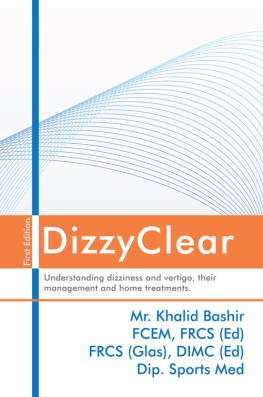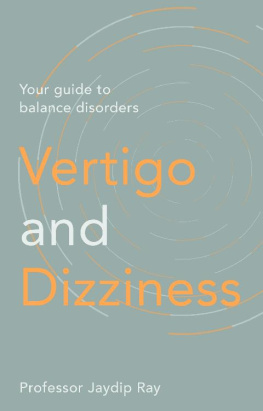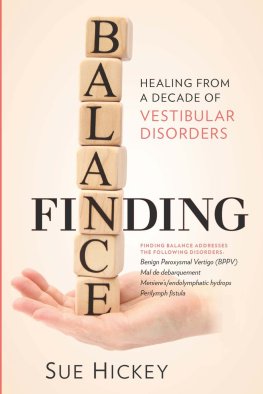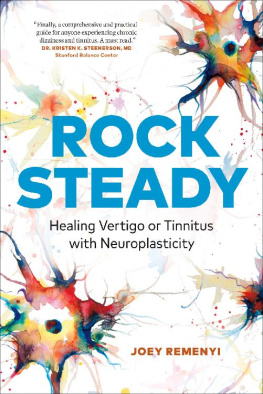
DIZZYCLEAR
Easy to understand dizziness and vertigo and their management, including home treatments.
Mr Khalid Bashir MD
Consultant and Head of Emergency Medicine Department
Bronglais General Hospital, Aberystwyth, United Kingdom
Specialist in otolaryngology, sports medicine and pre-hospital care
Fellow of College of Emergency Medicine (UK)
Fellow of Royal College of Surgeons (Edinburgh)
Fellow of Royal College of Surgeons (Glasgow)
Diploma in Immediate (pre-hospital) care, Royal College of Surgeons (Edinburgh)
Diploma in Sports Medicine (Cardiff)
Certificate in Aviation Medicine (London)
GMC Specialist register of emergency medicine and general practice
Chapters
Part 1
Chapter 1
Chapter 2
Chapter 3
Chapter 4
Chapter 5
Chapter 6
Chapter 7
Chapter 8
Chapter 9
Chapter 10
Chapter 11
Chapter 12
Chapter 13
Chapter 14
Chapter 15
Chapter 16
Chapter 17
Chapter 18
Chapter 19
Chapter 20
Chapter 21
Chapter 22
Part 2
Chapter 23
Chapter 24
Chapter 25
Chapter 26
Chapter 27
Chapter 28
Chapter 29
Poem
I had dizziness for two years
This brought forth my tears
Someone said it is your ears
Depression was stated by my peers
Stroke was one of my fears
I spent money on pills for years
And then I discovered Dizzyclear
Then my dizziness stopped
By a dizzy patient
Dedication
I would like to dedicate this book to my parents, who have contributed significantly in my life and helped me achieving the highest position in my field.
Foreword
Doctors and other medical personnel commonly come across patients with dizziness. The incidence of dizziness increases as one gets older. Patients with dizziness can present with and without vertigo sensation. It is quite a disabling symptom, although mostly there is no serious underlying cause. In the past, people suffered and lived with this condition, as care providers found it difficult to deal with it properly; however, with recent advances in technology and proper management of this condition, most people can get very effective treatment. The treatments are usually provided by ear nose and throat specialists, GPs or physiotherapists in the form of various exercises and short term medication.
Dizzyclear has been written by Mr Khalid Bashir, who has vast experience in treating these patients. For the last eleven years, he has successfully treated many patients in Bronglais General Hospital, Aberystwyth. This book also contains many easy to understand illustrations. There is currently a research project being undertaken in this hospital to look into the effectiveness of Epleys manoeuvre and home exercises for the treatment of benign paroxysmal positional vertigo. Initial results have shown significant benefit to these patients in this area of Wales. We feel this book, in simple format and basic structure on this subject, will benefit hospital doctors, GPs, practice nurses, medical students and physiotherapists dealing with dizzy patients on a regular basis.
Dr L Pandya MRCP (UK), MRCP (Ireland), Consultant Physician
Dr M Akram MRCP (UK), Specialty Doctor in Medicine
Important note
Every effort has been made to check the drugs and their doses. The readers are encouraged to consult the drug companys literature before administering any drugs listed in this book. The exercises recommended in this book should be performed in a safe environment, preferably supervised by a clinician or at least in the presence of a relative or a carer.
Directory of Terms
BPPV (Benign paroxysmal positional vertigo). This is a type of dizziness where surroundings appear to spin. It is associated with nausea with various head and neck movements (chapter 23).
Dix-Halpike manoeuvre This is a test for diagnosing BPPV. The head is brought in to various positions to induce dizziness (chapter 26).
Proprioception This is a subconscious sense that enables us to know where our limbs are in space with out having to look. The proprioceptive system consists of nerve receptors in muscles, ligament and tendons around the joints.
Nystagmus A repetitive and involuntary movement of the eyes. If it is present during vertigo diagnostic tests, then the vertigo is very likely due to an inner ear problem.
Grommet A grommet is a small tube inserted into the eardrum, mainly to prevent accumulation of mucus in the middle ear. However, one rare indication of grommet insertion is vertigo due to Menieres disease.
Inner ear Called labyrinth due to its complex shape, the inner ear is situated in the bone behind the ear (petrous part of the temporal bone). It consists of a bony part, called osseous labyrinth and a membranous part, called membranous labyrinth. The labyrinth consists of three parts: 1) cochlea is the anterior part of the labyrinth. It is coil-shaped and is responsible for hearing 2) vestibule is the central part 3) semi-circular canals are the posterior part of the labyrinth. There are three semi-circular canals named according to their position: superior, posterior and horizontal. The semicircular canals and vestibule are concerned with balance.
Vestibular system The part of the inner ear concerned with balance is called the vestibular system. It consists of semi-circular canals and otolith organs. Otolith organs are fluid-filled pouches that lie between the semicircular canals and the cochlea. They are called the utricle and the saccule. These inform the brain when our body is moving in a straight line, such as when standing up or riding in a car. They also inform the brain about the position of our head in relation to the ground, for example, whether we are lying down or sitting
Vestibular rehabilitation therapy (VRT) This is an exercise-based treatment offered to patients for both acute and chronic dizziness. The following exercises are most commonly used:
Cooksey-Cawthorne Exercises (chapter 24)
Gaze Stabilisation Exercises (chapter 25)
Canalolith repositioning manoeuvres, such as Epleys manoeuvre, Semonts manoeuvre and Brandt Baroffs home exercises (chapters 27&28)
CT scan (Computerised tomogram) This is a special type of X-ray using a scanner and a computer to take pictures and analyse them. It produces scans in cross-sections. Some scanners are able to turn images into 3-D images.
MRI scan (Magnetic resonance imaging This is a special type of scan which uses strong magnetic field and radio waves and computers to take and analyse detailed pictures of the brain and spine. It is excellent in differentiating between normal and abnormal soft tissues. There is no radiation exposure to the patient, hence, it is.
Introduction
Do you ever feel dizzy when you get up too quickly, when you change position in the bed, following travel by air, boat or road, or a head injury, or when you turn your head suddenly? You are not alone! Millions of people suffer from dizziness, but few know that effective treatment is available. There are many books available in the market about dizziness that deal with various aspects of dizziness and vertigo. Some of them are difficult to understand by non-medical personnel and others provide much more detail.
Next page







